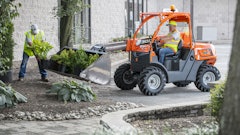
With spring just around the corner, landscapers everywhere will be preparing for their busiest time of the year. Whether it's hiring extra help, stocking up on service items and parts or adding new customers to routes, there is no shortage of prep work to be done. Getting your tools ready is a crucial step that should not be overlooked. Even if you winterized your equipment before putting it in storage, there are still several things you can do to ensure that your tools are ready for the tough season ahead. We know professionals put their machines through a lot of heavy use, and because of this, you are probably already taking great care of your equipment.
Whether they’re in your head, printed in your shop or managed in a computer program, it’s a good idea to make sure you’re paying attention to regular maintenance items to prevent more serious (and expensive) issues from creeping up during the season. Just in case you’re ready for a refresher, we’ve got several things to keep on top of mind as you run through all your checklists.
It doesn’t matter if you’re using a string trimmer, edger or hedge trimmer, you’ll want to make sure to keep the gear box greased and clean the tool regularly. Changing edger blades, trimmer line and keeping cutting blades sharp are regular maintenance items that should be done as needed but are easier to find if you’re in the habit of cleaning and checking your tools regularly. Leaf blowers should be stored safely with the tube in a way that prevents buckling and cracking of the rubber elbow.
Daily maintenance tasks should include cleaning the external surfaces of the machine, checking the throttle trigger lockout and inspecting the engine, fuel tank and fuel lines for any visible signs of leaks, cracks or other wear and tear. If you're using hedge trimmers, don't forget to give the cutting unit a once-over for any damage. Weekly maintenance routines should include checking for loose screws, inspecting the vibration dampening units, cooling systems, starter and starter rope and giving the carburetor's external surface a good cleaning. There are other items that should be done monthly, but don't worry about keeping track of it all; your tool's owner's manual will have a comprehensive checklist to ensure that your tool stays in peak condition. Don't forget that most owner's manuals are available on manufacturer's websites just in case the original has been misplaced.
When it comes to less frequent and more labor-intensive maintenance items like carburetors and engines, regular inspections are crucial. Without them, what could have been small repairs can turn into costly downtime in the peak of the spring and summer seasons. However, even with proper care, it's not uncommon for carburetor rebuilding or replacement to be necessary after a couple of years of heavy use. Keep a keen eye out for leaks and other potential issues, especially as your equipment ages.
Speaking of engines, draining the fuel tank and fuel lines at the end of the cutting season is a must-do for professional landscapers. Skipping this step could lead to serious carburetor issues down the line. This is especially true if you use fuel that you’re mixing by hand. While two-stroke engines may seem indestructible, they’re still combustion engines that harness controlled fuel explosions to set the moving parts in motion. All that soot, exhaust and oil combined with moving parts makes it easy for things to break over time. Poor fuel quality will only speed up this process, so it’s important to make sure you’re starting each season with fresh fuel in the machine.
 Husqvarna
Husqvarna
Choosing the right fuel isn’t a maintenance item, per se, but it is crucial for extending the life of your equipment. Opting for a premixed fuel specifically designed for your engine, like the one offered by Husqvarna, can help keep things running smoothly and prevent degradation in your fuel tank. If you prefer gasoline, just remember to keep an eye on fuel quality, as poor-quality fuel can wreak havoc on your carburetor and fuel system. And don't forget to drain those fuel lines before storing your equipment for extended periods.
If you're in the market for new equipment and want to minimize maintenance, battery-powered tools might be worth considering. With fewer moving parts to worry about, battery-powered tools offer a low-maintenance alternative to traditional gas-powered equipment. Battery equipment still requires some upkeep. There are still gearboxes to grease, blades to sharpen or change, trimmer line to re-feed. All of this is still less demanding and costly than the engine maintenance needed for their gas-powered counterparts. With electric tools, you don't have to worry about fuel degradation—all you need to do is keep those batteries charged and ready to go.
So, as you gear up for the spring season, don't forget to give your handheld power equipment the attention it deserves. With a little maintenance now, you'll likely avoid costlier issues during peak season.




















